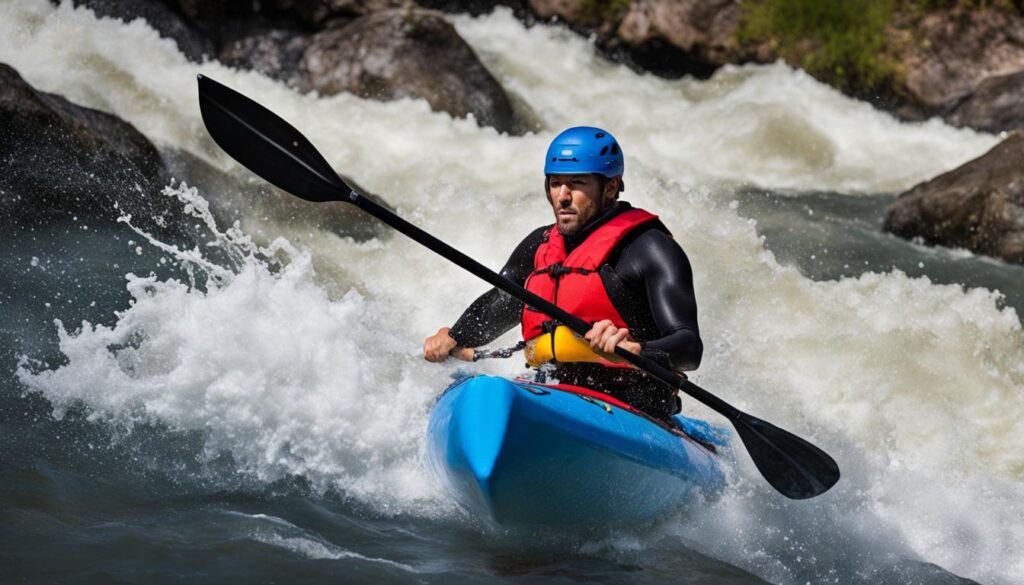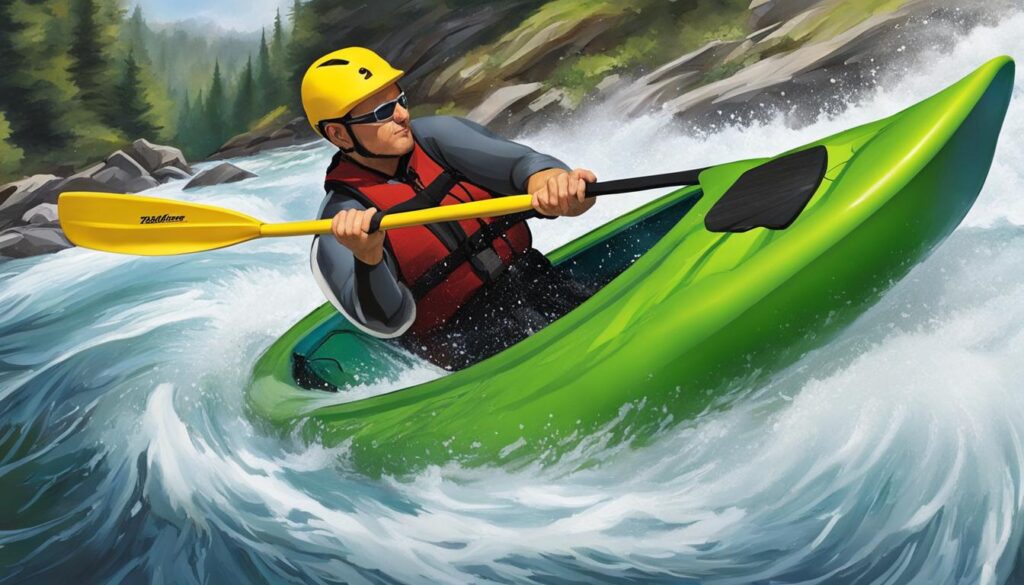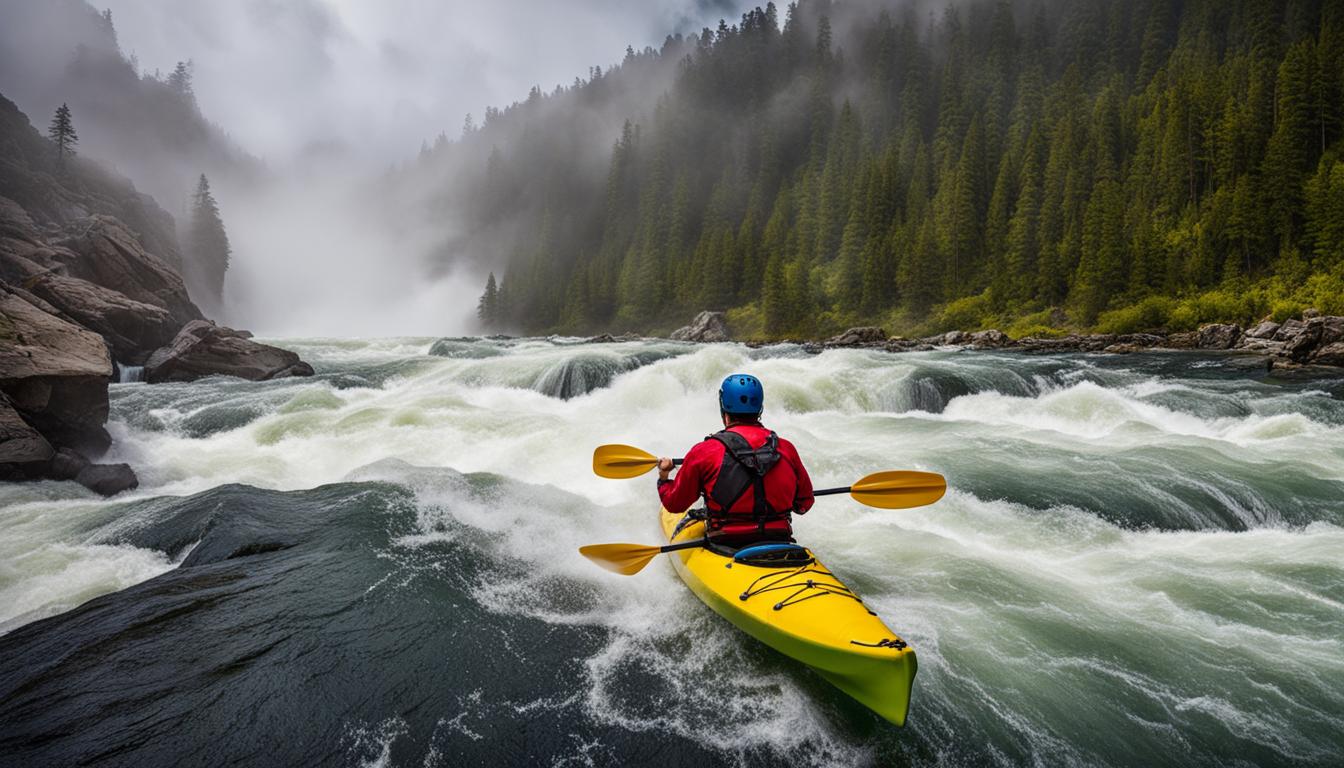Mastering paddle strokes is the key to success in whitewater kayaking. These essential techniques allow you to navigate rapids with precision and control, ensuring an exhilarating and safe experience on the water. In this article, we will explore the most effective paddle strokes for whitewater kayaking and provide valuable tips on how to execute them properly.
Key Takeaways:
- Learning and practicing paddle strokes is crucial for achieving success in whitewater kayaking.
- The forward stroke is the foundational stroke that propels the kayak forward with power and speed.
- The reverse stroke allows you to maneuver backward and maintain control in tight spaces.
- The sweep stroke helps you turn and maneuver your kayak with ease in various directions.
- The draw stroke enables sideways movement and precise positioning in challenging conditions.
- Choosing the right paddle that suits your style and budget is essential for optimal performance.
- Proper paddle technique, including holding the paddle correctly and engaging the core muscles, enhances efficiency and reduces the risk of injury.
By focusing on mastering these paddle strokes and applying the right techniques, you can elevate your whitewater kayaking skills and confidently tackle any rapids that come your way. So grab your paddle, hit the water, and embark on a thrilling adventure!
The Forward Stroke – Propel Your Boat with Power
The forward stroke is a fundamental paddle stroke for whitewater kayaking, providing the power needed to propel your boat through rapids and maintain speed. To execute the forward stroke effectively, start by engaging your core and back muscles, allowing for a strong and stable foundation. As you rotate your torso, reach forward with the paddle, immersing the blade fully into the water.
To generate power, pull the paddle blade towards your body, using the larger muscles in your torso and back. This motion will transfer the force from your body to the paddle, propelling your boat forward with each stroke. It’s important to maintain an upright posture and avoid hunching over the kayak, as this can limit your power and control.
Beyond power, efficiency is key when executing the forward stroke. Make sure to fully immerse the paddle blade in the water, maximizing its contact with the water for each stroke. This will help you create a smooth, continuous motion and minimize the energy wasted on splashing and air strokes.
| Key Points for the Forward Stroke: |
|---|
| Engage your core and back muscles for stability and power |
| Rotate your torso and reach forward with the paddle blade |
| Fully immerse the paddle blade in the water |
| Pull the paddle blade towards your body, using larger muscles |
| Maintain an upright posture for optimal power and control |
Remember, mastering the forward stroke is essential for generating power, maintaining speed, and improving your overall performance in whitewater kayaking. Practice this technique regularly and focus on incorporating the key points to enhance your paddling skills.
Mastering the Reverse Stroke – Move Backward with Control
The reverse stroke is an essential technique that allows you to move your kayak backward with ease and maintain control in challenging whitewater conditions. By mastering this kayak paddle technique, you’ll be able to navigate tight spaces, avoid obstacles, and make precise movements in the water.
The proper execution of the reverse stroke involves a series of coordinated movements. Begin by immersing the paddle blade at your hip, ensuring that it is fully submerged in the water. Rotate your torso in the opposite direction and pull the blade towards your body, generating propulsion that moves the kayak backward. This technique enables you to brake effectively and maneuver with precision.
When performing the reverse stroke, it’s crucial to maintain a stable and balanced posture. Keep your upper body centered and engage your core muscles to provide stability and control. By doing so, you’ll be able to make quick adjustments and respond to changing river dynamics.
Benefits of Mastering the Reverse Stroke
“The reverse stroke gives you the ability to move your kayak backward and make precise movements in tight spaces. It provides crucial control and maneuverability, allowing you to navigate challenging rapids with confidence.” – Experienced Whitewater Kayaker
Mastering the reverse stroke is not only about moving backward; it’s about gaining control over your kayak in demanding situations. Whether you need to change your direction, avoid obstacles, or fine-tune your positioning, the reverse stroke is a valuable tool in your paddling arsenal.
| Benefits of the Reverse Stroke | How it Enhances Whitewater Kayaking |
|---|---|
| Improved maneuverability | Allows you to make precise turns and navigate through complex water features. |
| Enhanced control | Enables you to navigate tight spaces, avoid obstacles, and respond to challenging river dynamics. |
| Braking mechanism | Provides a reliable method for slowing down and stopping your kayak when necessary. |
By practicing and refining your reverse stroke, you’ll become a more confident and skilled whitewater kayaker. With the ability to move backward with control, you’ll be well-equipped to tackle the most challenging rapids and enjoy the thrill of navigating whitewater.

The Sweep Stroke – Turn and Maneuver with Ease
The sweep stroke is a fundamental paddle technique for whitewater kayaking that allows you to turn your boat and maneuver in different directions with ease. Whether you need to navigate through rapids or make quick directional changes, mastering the sweep stroke is essential for maintaining stability and control.
To execute the sweep stroke, start by extending your arms forward and immersing the paddle blade in the water at your feet. Then, sweep the paddle in a wide arc towards the back of your kayak, using your upper body to generate power. This motion creates a sweeping effect that propels the boat in the desired direction.
Proper technique and body positioning are key to executing an effective sweep stroke. Ensure that you maintain a relaxed grip on the paddle and engage your core muscles to stabilize your body. Remember to rotate your torso and lean slightly in the direction of the stroke to maximize your reach and power.
With the sweep stroke in your paddling repertoire, you’ll be able to confidently navigate through complex water features, make precise turns, and conquer challenging whitewater conditions. Practice this technique regularly to develop fluidity and finesse in your maneuvers, and soon you’ll be effortlessly gliding through the water like a pro!
Add the following table:
| Benefits of the Sweep Stroke | Technique Tips |
|---|---|
| Allows for quick directional changes | – Extend arms forward to start the stroke – Sweep the paddle in a wide arc towards the back of the kayak – Rotate your torso and lean in the direction of the stroke – Engage core muscles for stability – Maintain a relaxed grip on the paddle |
| Enables precise turns | – Immersing the paddle blade at the feet – Using upper body rotation for power – Leaning slightly in the direction of the stroke |
| Enhances boat stability | – Proper body positioning – Leaning in the direction of the stroke – Engaging core muscles |
The Draw Stroke – Sideways Movement and Positioning
The draw stroke is a fundamental kayak paddle technique that allows you to move your kayak sideways and position it with precision. Whether you need to navigate through tight spaces, dock your kayak, or avoid obstacles, mastering the draw stroke is essential for effective maneuvering in whitewater kayaking.
To execute the draw stroke, start by placing the paddle blade in the water a short distance from your kayak, towards the side you want to move. Gently drag the blade towards your body and then lift it out of the water before it reaches the kayak. This motion creates a sideways force that propels the kayak in the desired direction. Remember to engage your core and use your torso rotation to enhance the effectiveness of the stroke.
When performing the draw stroke, it’s important to maintain stability in your kayak. Keep your upper body relaxed and your lower body stable. By using the draw stroke with finesse and precision, you can make subtle adjustments to your boat’s position and navigate challenging situations with ease.

The draw stroke is a versatile technique that allows for quick and controlled sideways movement. It is often used in combination with other paddle strokes to execute advanced maneuvers in whitewater kayaking. Practice and mastery of the draw stroke will give you the confidence and skill to navigate tight spaces and position your kayak exactly where you need it to be.
Choosing the Right Paddle for Whitewater Kayaking
When it comes to whitewater kayaking, selecting the right paddle is crucial for a successful and enjoyable experience on the water. The paddle you choose should be well-suited to your paddling style, preferences, and budget. With different materials and designs available, it’s important to consider the advantages and disadvantages of each option before making a decision.
There are three main materials used in the construction of kayak paddles: aluminum, fiberglass, and carbon fiber. Aluminum paddles are the most affordable option, making them a popular choice for beginner kayakers or those on a tight budget. However, they are typically heavier, which can lead to increased fatigue during long paddling sessions.
Fiberglass paddles strike a balance between weight and affordability. They offer a lighter option compared to aluminum, providing improved performance and reduced strain on your arms and shoulders. Carbon fiber paddles, on the other hand, are the lightest and most high-performance option available. They are favored by experienced kayakers who prioritize speed and efficiency. However, they come with a higher price tag.
Ultimately, the right paddle for you will depend on your specific needs and preferences. If you’re just starting out in whitewater kayaking or have a limited budget, an aluminum or fiberglass paddle may be the best choice. If you’re a seasoned kayaker looking to enhance your performance, a carbon fiber paddle might be worth the investment. Remember to try out different paddles, if possible, to find the one that feels most comfortable and efficient in your hands.
The Importance of Proper Paddle Technique for Whitewater Kayaking
When it comes to whitewater kayaking, having proper paddle technique is of paramount importance. Not only does it allow you to navigate rapids with ease, but it also enhances paddling efficiency and reduces the risk of injury. By focusing on the correct technique, you can maximize your power, control your boat with precision, and ultimately improve your overall performance on the water.
One key aspect of proper paddle technique is holding the paddle correctly. By gripping the paddle with the right hand placement and maintaining a firm but relaxed grip, you can ensure optimal control and fluid movement through the water. Engaging the larger muscles in your body, such as your core and back muscles, is also crucial. These muscles provide the power and stability needed for effective paddle strokes.
Another important element of proper paddle technique is maintaining good posture. By sitting upright and avoiding slouching, you can optimize your body’s alignment and reduce strain on your back and shoulders. This not only improves your efficiency while paddling but also helps prevent fatigue and potential injury.
Developing your paddle technique:
- Take the time to practice and refine your paddle strokes in a controlled environment before tackling more challenging whitewater.
- Consider taking lessons or joining a kayaking club to receive guidance and feedback from experienced paddlers.
- Watch instructional videos or read books on kayak paddle technique to learn new tips and tricks.
- Experiment with different paddle strokes and techniques to find what works best for you and your paddling style.
Remember, mastering proper paddle technique is an ongoing process. It takes time, practice, and dedication to develop the necessary skills and muscle memory. But by prioritizing technique and focusing on the fundamentals, you can enhance your efficiency, control, and enjoyment while whitewater kayaking.
Conclusion
Congratulations on reaching the end of our article on paddle strokes for whitewater kayaking! We hope you found the information valuable and informative. Mastering these paddle strokes is crucial for navigating rapids, maneuvering with precision, and improving your overall paddling efficiency.
By practicing the proper techniques for forward strokes, reverse strokes, sweep strokes, and draw strokes, you’ll be able to confidently tackle any whitewater challenge that comes your way. Remember to choose the right paddle for your needs and focus on proper technique to enhance your performance on the water.
Whitewater kayaking is an exhilarating sport that requires dedication, practice, and a solid understanding of paddle strokes. By continually honing your skills and pushing your limits, you’ll unlock your full potential and experience the thrill of conquering rapids like never before. So grab your paddle, hop in your kayak, and embark on an adventure that will leave you breathless.
FAQ
What are the most important paddle strokes for whitewater kayaking?
The most important paddle strokes for whitewater kayaking are the forward stroke, reverse stroke, sweep stroke, and draw stroke.
How do I perform the forward stroke?
To perform the forward stroke, engage your core and back muscles, rotate your torso, and pull the paddle blade through the water.
When should I use the reverse stroke?
The reverse stroke is used to move the kayak backward or as a braking mechanism. It is useful for maneuvering in tight spaces and navigating obstacles.
How do I execute the sweep stroke?
To execute the sweep stroke, extend your arms forward, immerse the paddle blade in the water at your feet, and sweep it in an arc towards the back of the kayak.
What is the draw stroke used for?
The draw stroke is used to move the kayak sideways and position it for specific maneuvers, such as docking or avoiding obstacles.
How do I choose the right paddle for whitewater kayaking?
When choosing a paddle, consider factors such as material (aluminum, fiberglass, carbon fiber), performance, weight, and budget. Select a paddle that suits your preferences, paddling style, and budget.
Why is proper paddle technique important in whitewater kayaking?
Proper paddle technique improves paddling efficiency, reduces the risk of injury, and allows for better control of the kayak in rapids. It helps generate power, maintain stability, and make precise turns.





